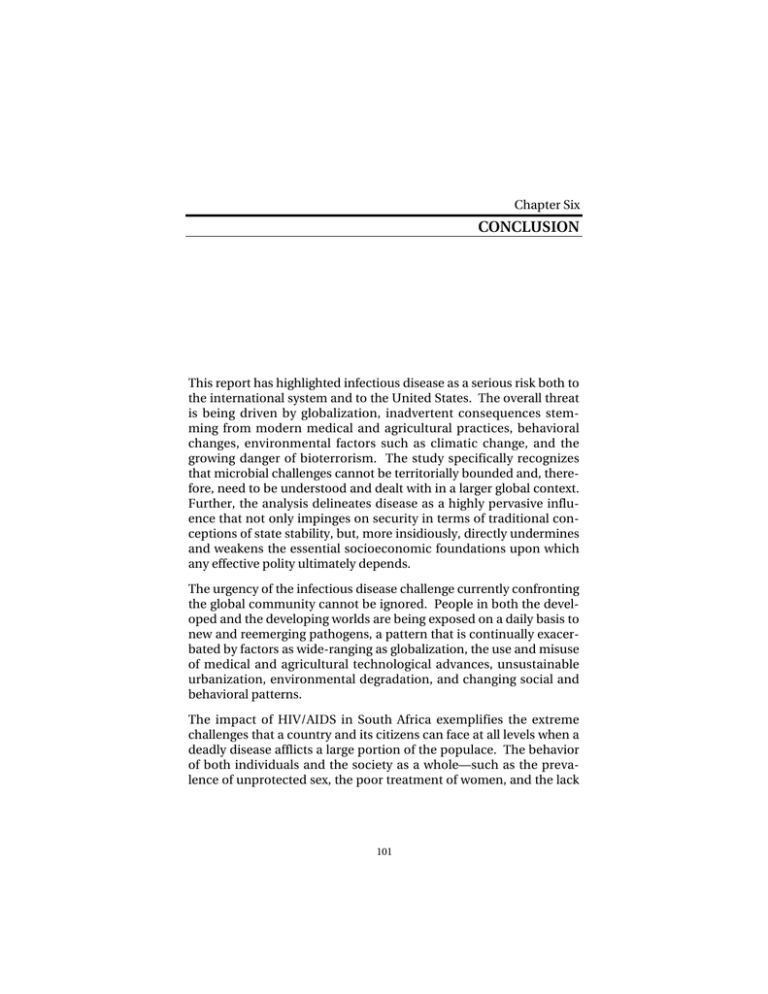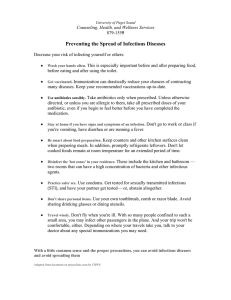CONCLUSION
advertisement

Chapter Six CONCLUSION This report has highlighted infectious disease as a serious risk both to the international system and to the United States. The overall threat is being driven by globalization, inadvertent consequences stemming from modern medical and agricultural practices, behavioral changes, environmental factors such as climatic change, and the growing danger of bioterrorism. The study specifically recognizes that microbial challenges cannot be territorially bounded and, therefore, need to be understood and dealt with in a larger global context. Further, the analysis delineates disease as a highly pervasive influence that not only impinges on security in terms of traditional conceptions of state stability, but, more insidiously, directly undermines and weakens the essential socioeconomic foundations upon which any effective polity ultimately depends. The urgency of the infectious disease challenge currently confronting the global community cannot be ignored. People in both the developed and the developing worlds are being exposed on a daily basis to new and reemerging pathogens, a pattern that is continually exacerbated by factors as wide-ranging as globalization, the use and misuse of medical and agricultural technological advances, unsustainable urbanization, environmental degradation, and changing social and behavioral patterns. The impact of HIV/AIDS in South Africa exemplifies the extreme challenges that a country and its citizens can face at all levels when a deadly disease afflicts a large portion of the populace. The behavior of both individuals and the society as a whole—such as the prevalence of unprotected sex, the poor treatment of women, and the lack 101 102 The Global Threat of New and Reemerging Infectious Diseases of a proactive response by the government—has exacerbated the spread of HIV as well as amplified its consequences, in terms of human life, confidence in government, political stability, and world standing. The HIV/AIDS epidemic has, in fact, left South Africa unprepared to meet its external military and, arguably, internal security obligations; incapable of fully meeting its economic potential; and ill-equipped to provide for the most basic social and health needs of its citizens. The United States has a myriad of programs and processes for combating the threat of infectious disease, most of which rest in local and state hands. While the CDC provides a level of integration for these assets and federal dollars have been set aside to help improve their effectiveness, overall national coordination and management remain ad hoc and disparate. Just as important, authority and resources vary widely across jurisdictions, at both the federal and the state and local levels. The result has been an underfunded and poorly coordinated public health infrastructure that is currently serving to impede U.S. disease surveillance, prevention, and response efforts. Further compounding the situation is the fact that the provision of U.S. foreign aid is largely based on narrow political, rather than more comprehensive health security, concerns. This has diverted scarce resources away from the areas where they are needed most and, in so doing, left many regions of the world as potential reservoirs of disease input into the country. To be sure, the September 11, 2001, attacks on the World Trade Center and the Pentagon, combined with the heightened fear of bioterrorism stemming from the 2001 anthrax crisis, have focused attention on the need for a strong public health infrastructure, and policymakers have begun to make funds available to address some of the fundamental shortcomings inherent in the system. However, this investment must be sustained and there is considerable work to do in enhancing overall policy coordination, management, and development. The federal government should consider playing a more concerted role in providing resources and instituting unified standards to provide consistent microbial protection across the country. At the same time, however, the nature of infectious diseases necessarily means Conclusion 103 that state and local authorities need to retain a measure of flexibility in implementing programs and ensuring that they are best able to meet their needs. Moreover, as noted in Chapter Five, public health issues remain a state function in the U.S. system, statutory authority for which, therefore, cannot constitutionally rest solely in federal hands. Within this general context, there are several specific and direct measures that could be instituted to address the shortcomings identified in this study: • Coordination among public health authorities at all levels of government needs to be substantially enhanced and developed in conjunction with mechanisms that allow for greater interaction across state borders and local boundaries. Progress in this area should proceed in conjunction with moves both to better integrate stovepipe surveillance systems and data formats and to expand existing capabilities for detecting and identifying infectious diseases through extramural research in universities and other academic centers. Increased federal investment is critical to these endeavors and could provide the basis from which to develop a functional, coherent national policy for combating infectious disease. • Greater thought needs to be given to how to involve the private sector in overall public health efforts, particularly in relation to the research, development, and manufacture of vaccines and antibiotics and the development of microbial surveillance technology. Options that the federal government might consider in this regard include funding basic research in appropriate areas and subsidizing the market for new products by agreeing to guarantee minimum purchasing contracts. The need for vaccines and appropriate medical devices to protect the military and civilian populations from biological agents should provide sufficient political justification to underwrite incentives of this sort. • A large-scale education and information campaign should be undertaken to explain the need for regular vaccination and highlight the importance of disease prevention through such practices as protected sex, the responsible administration of antibiotics, and “clean” needle exchanges. These programs must be conceived in such a way that they are not overly scientific—i.e., 104 The Global Threat of New and Reemerging Infectious Diseases that their meaning is not lost on the layperson (as has occurred in South Africa with the AIDS publicity drive). They must also be carefully managed to ensure that they raise awareness and understanding without unduly heightening public anxiety and fear. • Efforts should be made to augment the supply of healthcare workers currently available in the country. One relatively quick way to achieve this would be to create a dedicated public health service reserve that can be activated in the case of an emergency. This supplemental force could be trained for relatively low-level medical and public health duties, such as administering drugs and vaccinations, and retained on a schedule similar to that of military reservists—one weekend a month and two weeks a year. Over the longer term, funds will need to be invested to ensure the sustained provision of personnel with more advanced skills and training. To this end, monies should be directed toward supporting public health educational components at universities as well as facilitating ongoing professional training, particularly in the areas of disease detection, identification, diagnosis, and treatment. • Hospitals and emergency health facilities need to develop appropriate modalities for dealing with sudden crises and patient influxes, such as those that might occur in the aftermath of a bioterrorist attack. Medical receiving facilities should have the means to provide surge capacity in hospital beds and other vital functional areas and have in place auxiliary communication systems and power networks. Since regional or national transportation is likely to be affected by a terrorist event, hospitals should also have a plan to access backup laboratory facilities and procedures when they are unable to use their usual diagnostic services. • More resources need to be invested in foreign governments to help them increase the effectiveness of their internal disease prevention efforts. Useful initiatives that could be undertaken include mutual aid agreements for the sharing of biological intelligence, research, diagnostics, personnel, vaccines, antibiotics, medical devices, and treatment/prevention techniques; help with the creation of dedicated regional health surveillance networks; assistance to promote sustainable urban development Conclusion 105 and regeneration schemes; and focused response efforts to deal with specific disease-promoting catalysts (such as unprotected sex and the spread of AIDS and other STDs in southern Africa). Beyond these six health-oriented initiatives, the United States also needs to revisit how it defines security and formulates mechanisms for its provision. Institutional structures that have traditionally focused on narrow, statecentric concerns will have to be expanded and developed to accommodate challenges that threaten broader societal interests. Increased cooperation among agencies and departments that have historically had little to do with one another— including defense, justice, intelligence, public health, agriculture, and environment—will also be required, as will new executive functions to coordinate such multidimensional policy responses.1 One specific area calling for drastic change is the field of national intelligence. Bodies such as the CIA and Defense Intelligence Agency (DIA) will have to become familiar with new operational contexts that require different analytical techniques, skills, mandates, and information-handling methods. Threat assessments and forecasts will need to be more closely grounded on scientifically formulated models that integrate the work of the medical research sector on new and reemerging diseases. Just as important, security analysts will need to devote greater attention to the epidemiological literature as part of their regular reading “diet.” Overseas monitoring activities will also need to encompass a somewhat wider ambit, focusing on such things as the effectiveness of national medical screening systems; prevailing geopolitical, social, economic, and environmental conditions that affect disease incidence; and state compliance with international health conventions and agreements. Indeed, countries that do not pose an obvious military security danger may be the ones most likely to pose a disease risk, owing to poorly developed and ______________ 1 Plans to establish a Department of Homeland Security could provide a useful prece- dent and model in this regard. Although specifically directed to counter terrorism, the new department will represent the first institutionalization of an integrated, interdepartmental body that has both programmatic and budgetary powers within the U.S. security structure. See, for instance, “White House Sets Out Blueprint for Homeland Security,” Financial Times, June 19, 2002. 106 The Global Threat of New and Reemerging Infectious Diseases underfunded public health systems. Such possibilities will need to be recognized and factored into strategic threat analyses.2 Given the influence that the United States retains in such major military/security-focused organizations as the North Atlantic Treaty Organization (NATO), Washington could, finally, play a leading role in adapting these institutions to take on a more specific public and global health role. New functional areas that might conceivably be instituted in this regard include disease crisis and consequence management through the provision of early warning and response indicators, backed up by ongoing and concerted global epidemiological surveillance.3 In developing such mandates, the United States could usefully capitalize on the nascent multitask framework that has already been established for collective political-military humanitarian missions around the world. Measures such as these will require ongoing political input and sustained financial commitment. Reform along the lines suggested above will require federal support as well as a better understanding of public health issues and how they affect national and global resilience and stability. Considerable policy attention and resources have already been devoted to shoring up defenses against the relatively low-probability scenario of a large-scale bioterrorist attack.4 By contrast, modalities for dealing with naturally occurring microbes and pathogens, which every year inflict a significant and growing human and economic toll, remain relatively underdeveloped. Serious assessments of the threat posed by infectious diseases suggest that this imbalance needs to be modified, as a matter of both fiscal responsibility and judicious public policy. ______________ 2 Simon Dalby has made many of these same arguments in relation to intelligence reform to deal with environmental threats to national security. See his “Security, Intelligence, the National Interest and the Global Environment.” 3 Recommendations of this sort were highlighted during a transnational issues session of the “Euro-Atlantic Relationship: Ready for the Global Era?” Wilton Park Conference, Wilton Park, UK, May 21–25, 2001. 4 More than $3 billion has been requested to prevent, detect, and treat terror-related health threats in FY 2002. See Helen Dewar, “Senate Bioterrorism Bill Doubles Bush’s Request,” Washington Post, November 16, 2001, p. A15.




